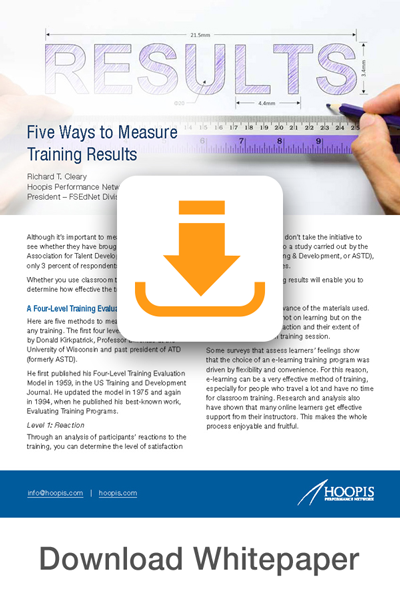Five Ways to Measure Training Results

Although it’s important to measure the effectiveness of training, many organizations don’t take the initiative to see whether they have brought any positive impact to the organization. According to a study carried out by the Association for Talent Development, or ATD (formerly the American Society of Training & Development, or ASTD), only 3 percent of respondents measure the impact of the training on their businesses.
Whether you use classroom training, e-learning or a combination of both, measuring results will enable you to determine how effective the training was.
A Four-Level Training Evaluation Model
Here are five methods to measure the results of any training. The first four levels were developed by Donald Kirkpatrick, Professor Emeritus at the University of Wisconsin and past president of ATD (formerly ASTD).
He first published his Four-Level Training Evaluation Model in 1959, in the US Training and Development Journal. He updated the model in 1975 and again in 1994, when he published his best-known work, Evaluating Training Programs.
Level 1: Reaction
Through an analysis of participants’ reactions to the training, you can determine the level of satisfaction they derived and the relevance of the materials used. In this level, the focus is not on learning but on the degree of learners’ satisfaction and their extent of appreciation for a given training session.
Some surveys that assess learners’ feelings show that the choice of an e-learning training program was driven by flexibility and convenience. For this reason, e-learning can be a very effective method of training, especially for people who travel a lot and have no time for classroom training. Research and analysis also have shown that many online learners get effective support from their instructors. This makes the whole process enjoyable and fruitful.
Level 2: Learning
Learning involves the provision of techniques, facts and principles that are key to providing information to trainees. In measuring learning, the focus is on establishing the degree of skills, attitudes and knowledge trainees have received during a training session. Unlike in reaction surveys, assessing the degree of a participant’s knowledge requires rigorous procedures.
Some organizations measure learning in this stage, while others use pre-tests and post-tests to evaluate and track trainees’ results from a training session. Evaluating learning through pre-tests and post-tests has proved a suitable method to gauge the level of learning participants have achieved from any training session. For example, a study carried out by California State University, Northridge, showed that participants who underwent e-learning performed 20 percent better than traditional learners. Another study discovered that e-learners scored higher grades than traditional learners.
Level 3: Behavior
The behavior of any e-learning participant will likely improve. But it is always impossible to predict how any trainee is going to transfer the knowledge gained during the training session to the actual workplace. Most e-learning training focuses on changing on-the-job behavior, even though at times it is hard to measure such change using test scores or analyzing trainees’ feelings.
However, there is some level of connection between hoped-for consequences and behavioral change. The challenges that affect an organization’s measure of the effectiveness of a certain training session have led to the need for organizations to measure their results as opposed to evaluating trainees through pre-tests and post-tests. Such preference can be attributed to the fact that all business results have a significant effect on the level of clients’ or customers’ satisfaction. Thus, business results that do not have any effect on clients are considered bad, while those that increase the level of customer satisfaction are considered good.
Level 4: Results
In level 4, the focus is on evaluating efforts and processes. Performance results are important because they act as pointers to the level of client satisfaction. Training generally aims to achieve a lower rate of employee turnover, decreased absenteeism, increased productivity, higher quality and reduced costs. Despite having such goals, addressing the complexity of the evaluation process remains a challenge for most organizations. Some organizations measure the efficacy of e-learning results by analyzing the volume of sales.
An Important Quantitative Measure
A fifth way to measure your training program, not included in Kirkpatrick’s list, is quantitative — assess the return on investment. Compare the cost of the training with returns from sales to evaluate the monetary value your organization gains — after carrying out the training.
Using these qualitative and quantitative measures of your training program’s value will guide your decisions about future training and its delivery method. Measuring training results will keep you from wasting time, money and effort on training that isn’t moving your company or firm forward.
Finally, LIMRA reports that millennials and women recruits use organizations’ technology capabilities and their education and learning resources to help determine which firm to join and remain with. E-learning not only can provide the flexibility they seek for a balanced lifestyle; it also can deliver quick and easily available content on any specific topic on demand, when the need arises.
An Effective Training Platform for Managers and Advisors
An effective resource for training financial advisors is Hoopis Performance Network, which features online, on demand, total video-based training built on four Disciplines of Success with access to more than 400 sessions. The coursework can be either self-study or facilitator-led, and it complements any firm, agency or company training programs and marketing selling systems. Your advisors can access the video training anytime, anywhere, on their computers, smartphones or tablets. It’s a cost-effective, time efficient way to increase productivity, thus retention.
An effective resource for training new or experienced sales leaders is HPN, an innovative virtual platform designed for financial leaders who are building a region, an agency or firm, a sales unit or a sales team. You can get access to hundreds of high-impact sessions for all levels of experience, divided into five distinct elements of success. These sessions are short and easily digestible, averaging less than 10 minutes. Your managers, wholesalers and leadership teams can access the video training anytime, anywhere, on their computers, smartphones or tablets.



